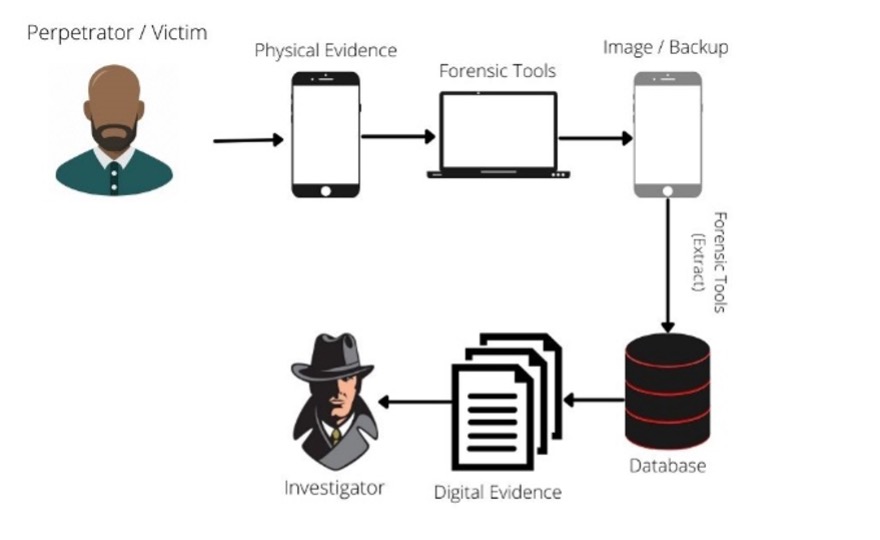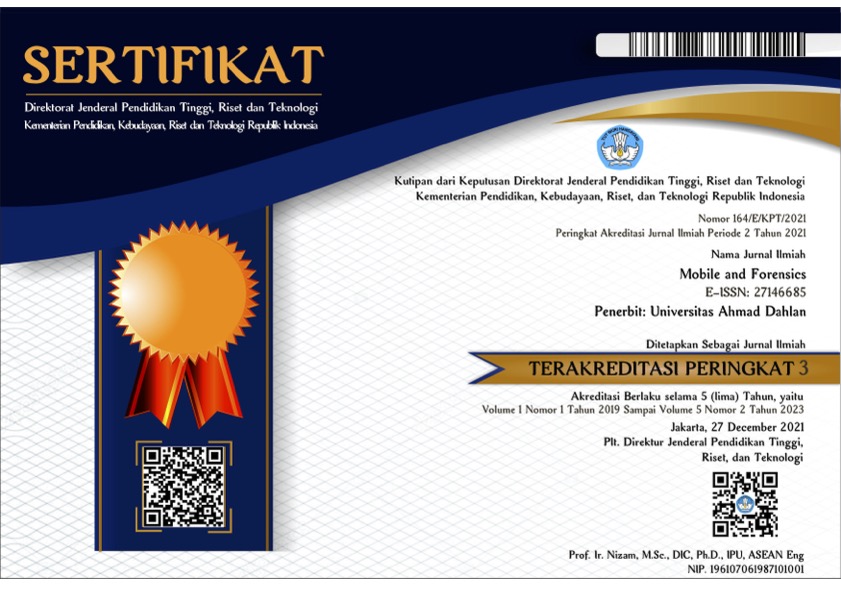Forensic Digital Analysis of Telegram Applications Using the National Institute Of Justice and Naïve Bayes Methods
DOI:
https://doi.org/10.12928/mf.v5i2.7893Keywords:
Digital Forensics, National Institute of Justice, Naive Bayes, Telegram, InvestigationAbstract
Currently, Telegram is an instant messaging application that is often used by the Indonesian people as a means of long-distance communication with other users. Telegram also has good security features to protect all data from its users. However, Telegram has a positive impact on its users. This security feature can be used by several people to protect against digital crimes, especially cases of sexual harassment. To overcome the existing crimes, analysis, and forensic methods are needed to help solve crimes. This research is guided by the investigation process using the National Institute Of Justice (NIJ) method and the Naïve Bayes method to classify the conversations found. It can be concluded that MOBILedit Forensic Express has a poor performance in finding digital evidence in the Telegram application and FTK Imager is very good at finding digital evidence in the Telegram application. In this research, the classification process using the Naïve Bayes method has been able to classify conversations that contain sexual harassment or not. Evaluation of the classification method uses a confusion matrix to determine the best classification model.
References
S. Azizah, S. A. Ramadhona, and K. W. Gustitio, “Analisis Bukti Digital pada Telegram Messenger Menggunakan Framework NIST,” JR, vol. 2, no. 10, pp. 1400–1405, Sep. 2020, doi: 10.22219/repositor.v2i10.1066.
I. Riadi, R. Umar, and M. A. Aziz, “Forensik Web Layanan Instant Messaging Menggunakan Metode Association of Chief Police Officers (ACPO),” MF, vol. 1, no. 1, p. 30, Sep. 2019, doi: 10.12928/mf.v1i1.705.
M. S. Asyaky, N. Widiyasono, and R. Gunawan, “Analisis dan Perbandingan Bukti Digital Aplikasi Instant Messenger pada Android,” SinkrOn, vol. 3, no. 1, pp. 220–231, Sep. 2018.
F. N. Rosyidah and M. F. Nurdin, “Media Sosial: Ruang Baru dalam Tindak Pelecehan Seksual Remaja,” j.sosioglobal, vol. 2, no. 2, p. 38, Jul. 2018, doi: 10.24198/jsg.v2i2.17200.
N. Tarmizi, S. Saee, and D. H. Abang Ibrahim, “Detecting the Usage of Vulgar Words in Cyberbully Activities from Twitter,” Int. J. Adv. Sci. Eng. Inf. Technol., vol. 10, no. 3, pp. 1117–1122, Jun. 2020, doi: 10.18517/ijaseit.10.3.10645.
A. Raza and M. Bilal Hassan, “Digital Forensic Analysis of Telegram Messenger App in Android Virtual Environment,” mob.forensics.j, vol. 4, no. 1, pp. 31–43, Mar. 2022, doi: 10.12928/mf.v4i1.5537.
R. Octora, “PROBLEMATIKA PENGATURAN CYBERSTALKING (PENGUNTITAN DI DUNIA MAYA) DENGAN MENGGUNAKAN ANNONYMOUS ACCOUNT PADA SOSIAL MEDIA,” dialogia, vol. 11, no. 1, pp. 77–96, Nov. 2019, doi: 10.28932/di.v11i1.1902.
K. Budiman, N. Zaatsiyah, U. Niswah, and F. M. N. Faizi, “Analysis of Sexual Harassment Tweet Sentiment on Twitter in Indonesia using Naïve Bayes Method through National Institute of Standard and Technology Digital Forensic Acquisition Approach”.
I. Riadi, “PERBANDINGAN TOOL FORENSIK DATA RECOVERY BERBASIS ANDROID MENGGUNAKAN METODE NIST”.
I. Anshori, K. E. Setya Putri, and U. Ghoni, “Analisis Barang Bukti Digital Aplikasi Facebook Messenger Pada Smartphone Android Menggunakan Metode NIJ,” ITJRD, vol. 5, no. 2, pp. 118–134, Aug. 2020, doi: 10.25299/itjrd.2021.vol5(2).4664.
I. Riadi, R. Umar, and I. M. Nasrulloh, “ANALISIS FORENSIK DIGITAL PADA FROZEN SOLID STATE DRIVE DENGAN METODE NATIONAL INSTITUTE OF JUSTICE (NIJ),” ELINVO, vol. 3, no. 1, pp. 70–82, Jul. 2018, doi: 10.21831/elinvo.v3i1.19308.
M. N. Randhika, J. C. Young, A. Suryadibrata, and H. Mandala, “Implementasi Algoritma Complement dan Multinomial Naïve Bayes Classifier Pada Klasifikasi Kategori Berita Media Online,” Ultimatics, vol. 13, no. 1, pp. 19–25, Jun. 2021, doi: 10.31937/ti.v13i1.1921.
M. N. Randhika, J. C. Young, A. Suryadibrata, and H. Mandala, “Implementasi Algoritma Complement dan Multinomial Naïve Bayes Classifier Pada Klasifikasi Kategori Berita Media Online,” Ultimatics : Jurnal Teknik Informatika, vol. 13, no. 1, pp. 19–25, 2021, doi: 10.31937/ti.v13i1.1921.
M. I. Fikri, T. S. Sabrila, and Y. Azhar, “Perbandingan Metode Naïve Bayes dan Support Vector Machine pada Analisis Sentimen Twitter,” Smatika Jurnal, vol. 10, no. 02, pp. 71–76, 2020, doi: 10.32664/smatika.v10i02.455.
Merinda Lestandy, Abdurrahim Abdurrahim, and Lailis Syafa’ah, “Analisis Sentimen Tweet Vaksin COVID-19 Menggunakan Recurrent Neural Network dan Naïve Bayes,” Jurnal RESTI (Rekayasa Sistem dan Teknologi Informasi), vol. 5, no. 4, pp. 802–808, 2021, doi: 10.29207/resti.v5i4.3308.
R. Sari and R. Y. Hayuningtyas, “Penerapan Algoritma Naive Bayes Untuk Analisis Sentimen Pada Wisata TMII Berbasis Website,” Indonesian Journal on Software Engineering (IJSE), vol. 5, no. 2, pp. 51–60, 2019, doi: 10.31294/ijse.v5i2.6957.

Downloads
Published
Issue
Section
License
Copyright (c) 2023 meyti eka

This work is licensed under a Creative Commons Attribution-ShareAlike 4.0 International License.
Start from 2019 issues, authors who publish with JURNAL MOBILE AND FORENSICS agree to the following terms:
- Authors retain copyright and grant the journal right of first publication with the work simultaneously licensed under a Creative Commons Attribution License (CC BY-SA 4.0) that allows others to share the work with an acknowledgment of the work's authorship and initial publication in this journal.
- Authors are able to enter into separate, additional contractual arrangements for the non-exclusive distribution of the journal's published version of the work (e.g., post it to an institutional repository or publish it in a book), with an acknowledgment of its initial publication in this journal.
- Authors are permitted and encouraged to post their work online (e.g., in institutional repositories or on their website) prior to and during the submission process, as it can lead to productive exchanges, as well as earlier and greater citation of published work.

This work is licensed under a Creative Commons Attribution-ShareAlike 4.0 International License.











 Mobile and Forensics (MF)
Mobile and Forensics (MF)